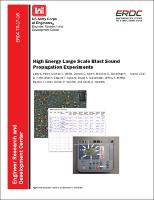Please use this identifier to cite or link to this item:
https://hdl.handle.net/11681/27269Full metadata record
| DC Field | Value | Language |
|---|---|---|
| dc.contributor.author | Pater, Larry L. (Larry Lamann), 1944- | - |
| dc.contributor.author | White, Michael J. | - |
| dc.contributor.author | Albert, Donald G. | - |
| dc.contributor.author | Swearingen, Michelle E. | - |
| dc.contributor.author | Wilson, D. Keith | - |
| dc.contributor.author | Nykaza, Edward T. | - |
| dc.contributor.author | MacAllister, Bruce A. | - |
| dc.contributor.author | Mifflin, Jeffery A. | - |
| dc.contributor.author | Jones, Bonnie J. | - |
| dc.contributor.author | Valente, Daniel P. | - |
| dc.contributor.author | Nemeth, Sarah B. | - |
| dc.date.accessioned | 2018-06-05T13:19:11Z | - |
| dc.date.available | 2018-06-05T13:19:11Z | - |
| dc.date.issued | 2017-03 | - |
| dc.identifier.govdoc | ERDC TR-17-16 | - |
| dc.identifier.uri | http://hdl.handle.net/11681/27269 | - |
| dc.identifier.uri | http://dx.doi.org/10.21079/11681/27269 | - |
| dc.description | Technical Report | - |
| dc.description.abstract | Atmospheric conditions greatly affect the propagation of the sound. Currently, little information exists regarding the amount of variation in level and spectra of blast noise that is caused by changing meteorological conditions along the propagation path. Available meteorological models accurately predict vertical sound speed profiles only up to the top of the boundary layer. For long-range propagation, this is inadequate. Vertical sound speed profile data and resulting propagation effects will help to better explain the effects of atmospheric refraction in sound propagation. This report detailed the procedures and equipment used to carry out a series of blast noise experiments at White Sands Missile Range, NM and Fort Leonard Wood, MO from 2007 to 2009. The data provided by this large-scale experiment comprise a definitive dataset for the effects of a wide range of meteorological conditions on long-range high-energy blast sound propagation in climate types similar to the majority of continental United States (CONUS) military installations (arid desert and temperate vegetated). The experiment also captured a comprehensive set of meteorological measurements over the duration of the experiments. | en_US |
| dc.description.sponsorship | U.S. Army Public Health Command. | en_US |
| dc.format.extent | 55 pages/4.252 Mb | - |
| dc.format.medium | - | |
| dc.language.iso | en | en_US |
| dc.publisher | Construction Engineering Research Laboratory (U.S.) | en_US |
| dc.publisher | Cold Regions Research and Engineering Laboratory (U.S.) | en_US |
| dc.publisher | Engineer Research and Development Center (U.S.) | en_US |
| dc.relation.ispartofseries | Technical Report (Engineer Research and Development Center (U.S.)) ; Report No. ERDC TR-17-16 | - |
| dc.rights | Approved for Public Release; Distribution is Unlimited | - |
| dc.source | This Digital Resource was created in Microsoft Word and Adobe Acrobat | - |
| dc.subject | Sound-waves | en_US |
| dc.subject | Sound--Transmission | en_US |
| dc.subject | Explosions | en_US |
| dc.subject | Noise pollution--Meteorological aspects | en_US |
| dc.title | High energy large scale blast sound propagation experiments | en_US |
| dc.type | Report | en_US |
| Appears in Collections: | Technical Report | |
Files in This Item:
| File | Description | Size | Format | |
|---|---|---|---|---|
| ERDC TR-17-16.pdf | 4.35 MB | Adobe PDF |  View/Open |